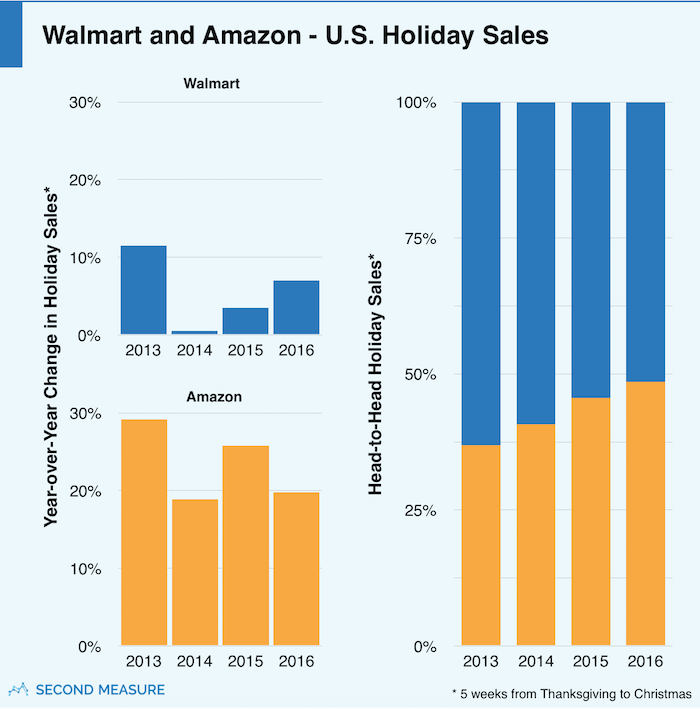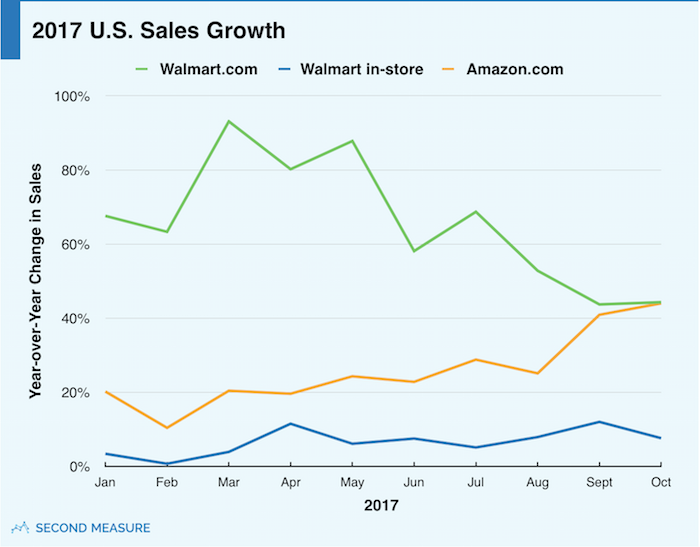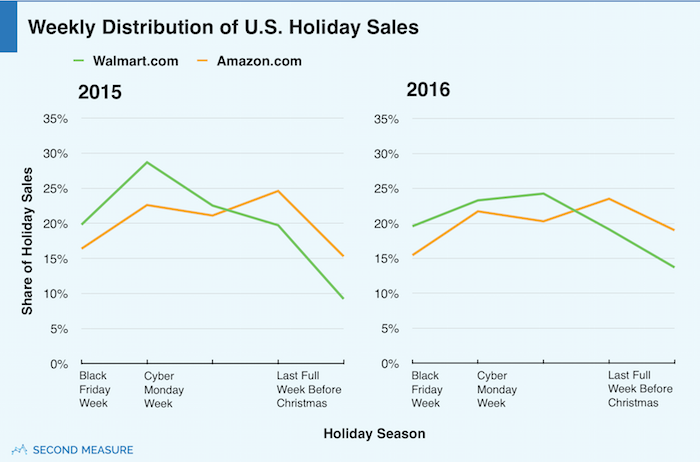NOTE: Bloomberg Second Measure launched a new and exclusive transaction dataset in July 2022. Our data continues to be broadly representative of U.S. consumers. As a result of this panel change, however, we recommend using only the latest posts in assessing metrics, and do not support referring to historical blog posts to infer period-over-period comparisons.
It’s the most wonderful time of the year: 2017 holiday shopping is underway. As America’s biggest retailer, Walmart has outsold rival Amazon throughout past holiday seasons. But debit and credit card transactions at both companies show Amazon has been steadily narrowing the gap.
In 2016, Walmart’s yearly U.S. debit and credit card sales (in-store and online) were 49 percent higher than Amazon’s, but its lead in holiday sales was much tighter—only 6 percent. And from 2015 to 2016, Amazon’s U.S. holiday sales grew nearly three times as fast as Walmart’s. If these trends continue, 2017 may add up to be the year that Amazon’s U.S. holiday debit and credit card sales surpass Walmart’s.

One important caveat is that Second Measure’s consumer spending data doesn’t include purchases made with cash, check, or EBT (food stamps). These payment methods are commonly used at Walmart, so the company’s relative sales are higher than what we observe. Still, there’s little question Amazon is making gains during the holiday shopping season.
It’s a small segment of total sales, but Walmart.com grew the most
As Amazon creeps closer to Walmart in total sales, Walmart.com is positioned to take a bigger slice of the online-holiday pie. Just a fraction of Walmart’s U.S. business comes from e-commerce—6 percent of its holiday credit and debit card sales last year. But online business is growing. Through October of this year, Walmart’s 2017 online sales increased 65 percent from 2016 levels. In-store credit and debit card spending at Walmart was up by 7 percent over the same period, while Amazon’s sales grew by 26 percent.

Still, Amazon is by far the largest e-commerce retailer in the U.S. It’s a convenient choice for many shoppers facing a time-crunch late in the holiday season, when Amazon’s customers spend the most. The last full week before Christmas has been Amazon’s biggest holiday-sales week for the past four years.

But there are signs that Walmart’s online customers are starting to shop more like Amazon’s. As business grows for Walmart.com, its distribution of sales across the holiday season has shifted closer toward the Amazon trend. Back in 2015, Walmart.com shoppers spent most during Cyber Monday week, and holiday sales grew just 4 percent year-over-year. Last year, holiday spending peaked later in the season, and Walmart.com holiday sales increased by 30 percent.
As Amazon has long known and Walmart is now finding, there’s big money to be made from last-minute shoppers who don’t have time to go to stores. This year, Walmart’s increasingly competitive online rollbacks and two-day shipping option are giving holiday shoppers an attractive Amazon alternative. In January, Walmart announced free two-day shipping on orders over $35. This will be the first holiday season to see if the perk helps Walmart.com capture more end-of-season sales.
To find out which retailer wins the holiday shopping race this year, request a demo today.
Editor’s Note: This story has been updated to reinforce that Second Measure does not capture purchases made with cash, check, or EBT.
